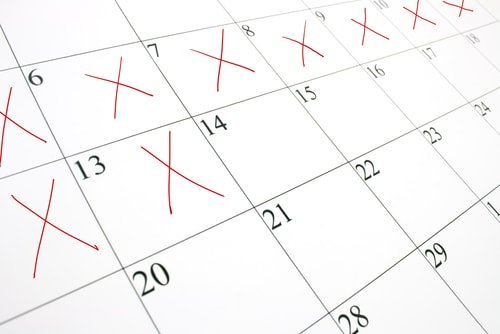How to Build Healthy Habits for Weight Loss
When you think about how to build healthy habits for weight loss, you probably think about stocking your pantry with healthy foods and making better dietary choices.
However, habits that you make outside the kitchen play a big role in weight loss too.
Motivation drives us forward in whatever we do.
If we’re not connected with our motivating factors while trying to lose weight, we might peter out earlier than we had hoped.
When you’re trying to lose weight, what’s your motivation?
For example:
- Do you want to fit into that trendy bikini this summer?
- Do you want to feel more comfortable in your favorite pair of jeans?
- Do you want to be more confident in your skin?
- Do you want to see the number on the scale go down?
- Do you want to have fewer aches and pains?
- Do you want more energy to keep up with your kids?
Being clear on what motivates you can help you stay on track.
It also helps you know where to restart your efforts if you’ve fallen off the wagon.
If you’re losing steam, pulling out a photo of that bikini can help you get a second wind. Remembering that old friend who gushed about how amazing you look can help remind you that you’re becoming more confident.
Stepping on the scale and seeing that the number has, in fact, gone down can make you put down that second helping.
Here are our favorite ways to build healthy habits for weight loss.
This post may contain affiliate links, which helps keep this content free. Please read our disclosure for more info.
1. Reward Yourself
You often hear people talk about rewards when it comes to weight loss. However, if you’re used to rewarding yourself with food, it can feel challenging to give yourself an effective pat on the back.
Tie your reward to your motivation.
If that bikini is keeping your weight-loss dreams alive, buy one that you love when you hit your first weight-loss goal. Instead of holding out for your favorite pair of jeans, purchase a pair that fits you like a glove and doesn’t dig into your love handles when you’ve lost the first 5 pounds.
When you start feeling more energetic, take the family on a special outing. Go to the zoo or hike to a scenic overlook to take advantage of your newfound vigor.
2. Set Small Goals
Try setting small, realistic, and specific goals when you’re trying to shed weight.
If you have your sights set too high, you might get discouraged.
Whenever you compliment someone on his or her weight loss, you often get the reply, “Thanks. I still have 20 pounds to go!”
While the compliment was probably a great reward for that person, the reminder of the ultimate goal is still a major hurdle. If that person had set smaller goals along the way, he or she may have responded, “Thanks. I’ve already hit my first two goals!”
What a difference it makes to satisfy smaller goals than to plod along toward an unreachable one.
Jerry Seinfeld used this strategy to train himself to be more productive and be a better comic, according to an interview between software developer Brad Isaac and the comedian himself.
Seinfeld set a goal to write every day. If he accomplished the goal, he would mark a red “X” on the calendar.

Within less than a week, it wasn’t important to him to write something hilarious. It was just important that he didn’t break the chain.
Skipping one day makes it easier to skip another day.
The key to making this strategy work is to keep your goals small enough that they’re easy to accomplish every day.
3. Make a Decision
Have you ever said that you were going to try to lose weight?
Trying isn’t the same as doing.
If you’re going to try to stay away from the cheese plate at a party, you’re likely to gorge on cheddar cubes at some point. If you say, “I’ve decided not to eat the cheese tonight,” you’re more likely to avoid it.
Be confident in your ability to stick to your decisions.
When you’re confident about your plans, you’re more likely to follow them.
4. Trick Your Willpower
We all know that willpower is a finite resource (1).
The more you deprive yourself, the more likely you are to ditch all self-control by the end of the day.
One interesting study involved putting participants in a room with freshly baked cookies and radishes. One group was told that they could sample the cookies. The other group was asked to eat the radishes instead.
Participants were then asked to complete a difficult puzzle. The group that had sampled the cookies had more self-control. They persevered for a longer period of time than the radish-eating group while completing the puzzle.
The group that had used willpower to avoid eating the cookies gave up on the puzzle more quickly.
If you’ve been restricting yourself all day, you’re more likely to give up on your healthy eating habits in the evening.
Instead of limiting your food options, expand them.
Some ways to do this are as follows:
- Eat all the vegetables you want for every meal.
- Concentrate on getting a variety of colors on your plate.
- Experiment with new cooking techniques, spices and flavorings.
- Eat something every few hours.
- Have fun with food.
Watch this video for more on this phenomenon.
5. Move Every Day
Many people think that if they don’t pound out a hard jog or lift heavy weights at the gym, it’s not worth working out.
The problem with this mentality is that it may make you burn out.
Developing a habit involves consistency.
If you burn out and stop exercising for a week, you’ve just taken a few steps back.
Make an effort to move your body daily. You don’t have to do HIIT training or run three miles; you just have to do something.
This could involve doing a 20-minute yoga flow, dancing in your living room, taking a 15-minute walk twice a day or playing Frisbee in the park.

You may notice that the more you move, the more you want to move.
Exercising earlier in the day can help you take advantage of your willpower to keep your healthy habit going.
6. Set Up Triggers
Are you used to eating something sweet after a meal? Do you tend to grab something crunchy while you’re watching TV?
Those are unhealthy triggers.
Lifehacker suggests tricking your body into wanting to follow healthier triggers by doing something healthy instead.
Go for a 5-minute walk after a meal. Do 50 crunches every time you sit down to watch TV. Get up and do a household chore every 15 minutes.
These triggers don’t have to be long or complex. Keeping them short and simple may be the best way to change your negative habits into lifelong healthy behaviors.
Lastly, if you need a program to help you establish healthier habits, we’ve got you covered. This is EXACTLY what our entire 21-Day Fat Loss Challenge is centered around.
There is a reason that the length of the Challenge is 21 days. It’s because it generally takes most people 21 days to establish a habit.
The Challenge is designed to break your unhealthy habits with foods, especially sugar, refined carbohydrates, and other processed foods, and establish new, healthy habits in their place.
The best part is, the Challenge was designed in such a way that it can be repeated in multiple rounds if you have more weight to lose. The majority of our clients are over 200 lbs, and they are having fantastic success with the program.
We now have over 2,000 people in our private support group for the Challenge.
If you are READY to make a change in your life and build healthy habits for weight loss that will last a lifetime, check out our 21-Day Fat Loss Challenge to get started TODAY!
If you enjoyed this article on how to build healthy habits for weight loss or have any questions for us, please leave them in the comment section below!



Thanks for sharing this useful information about how to reduce fat to lower the weight.